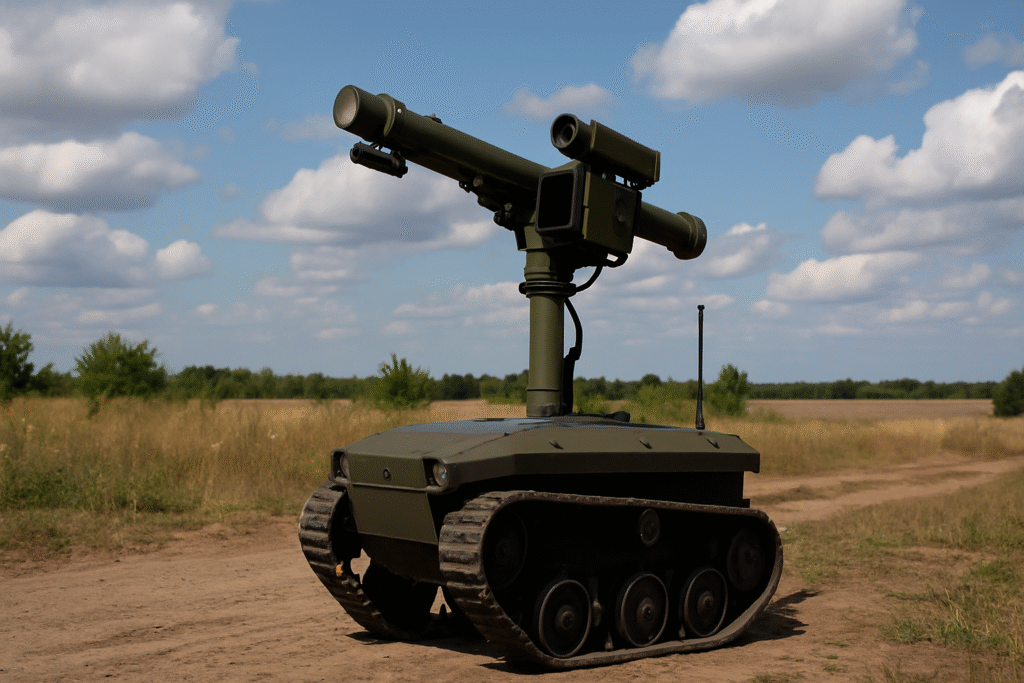In a groundbreaking leap for battlefield innovation, Ukrainian soldiers have developed a robotic air defense system that blends agility, precision, and remote operation. This invention a fusion of a 4×4 unmanned ground vehicle (UGV) and a shoulder fired Igla MANPADS has already marked its place in modern warfare by downing an enemy helicopter.
Behind this bold achievement stands Ukraine’s 28th Mechanized Brigade, whose ingenuity has reshaped how short range air defense can be deployed under fire.
How the Robotic Air Defense System Works
The robotic air defense system integrates a MANPADS (Man Portable Air Defense System) onto a mobile ground platform capable of remote operation. The vehicle, powered by electric or hybrid motors, is equipped with sensors, a fire control system, and stabilized mounts that hold the Igla launcher. This allows the operator to engage aerial threats from a safe distance without exposing themselves to counterattacks.
We built this system because necessity pushed us to innovate under pressure, says Serhiy Holub, an engineering sergeant with the 28th Brigade. Our goal was to save lives and bring technology to the frontlines where it matters most.
The system not only allows rapid repositioning but can also function autonomously on patrol routes, feeding real-time visuals to command centers while standing by for enemy aircraft.
The newly developed robotic air defense system wasn’t just a prototype stuck in testing. In early July 2025, it successfully targeted and destroyed a Russian Ka-52 “Alligator” attack helicopter in the Kherson region. This confirmed kill sent shockwaves across military technology analysts worldwide.
Using a remote thermal imaging camera, the vehicle operator locked onto the incoming aircraft from a safe position over 2 kilometers away. The Igla missile was launched without human exposure, and seconds later, the Ka-52 exploded midair.
It was surreal, recalls Yurii, the drone operator controlling the robotic unit. The machine just did what it was designed to do. We were screaming and crying when we saw the impact this was a message to the world that Ukrainians don’t just defend we innovate.
Expert Opinions on the System’s Military Significance
Military experts from NATO and independent defense analysts have taken notice. Dr. Marissa Clarke, a senior researcher at the European Defense Strategy Institute, commented. This robotic air defense system is a landmark innovation. Unlike traditional MANPADS, this version removes the human element from the firing line, reducing risk and increasing tactical flexibility. It could change how infantry units defend themselves in open terrain.
Additionally, retired U.S. Army Colonel Thomas Nelsen emphasized the strategic implications. Ukraine is leading a grassroots AI and robotics revolution in warfare. This system offers cost effective, mobile, and decentralized air defense capabilities a nightmare scenario for any helicopter pilot.
The development wasn’t a corporate project or government funded startup. It was built in a workshop by engineers and mechanics within the brigade itself, using salvaged parts, 3D printed mounts, and software borrowed from drone technology.
Oleksandr, a 22 year old robotics enthusiast turned military techie, led the integration team. We knew the risks. We were building this just kilometers away from Russian artillery. But each part we added, each wire we soldered, it felt like revenge in the making. His story reflects the raw determination and resilience that have become trademarks of Ukraine’s resistance.
Why This Innovation Matters
The robotic air defense system exemplifies asymmetric warfare when a technologically or numerically weaker side compensates with creativity and agility. With aerial threats like kamikaze drones and low-flying helicopters being common in the Russia-Ukraine conflict, traditional air defense can be too slow or dangerous to deploy.
This system fills the gap:
Low cost: Built locally using available parts.
Scalable: Can be replicated and modified across units.
Safe: Keeps soldiers protected during air engagements.
Disruptive: Forces enemy aircraft to operate at higher altitudes or retreat.
More importantly, this is a testament to Ukraine’s strategy, empowering its soldiers not just to fight, but to invent on the battlefield.
Future Potential of Robotic Air Defense Systems
With the success of the initial unit, Ukraine is expected to scale the robotic air defense system across other brigades. Engineers are already working on improvements, such as integrating night vision, auto target tracking, and linking the system to overhead drone reconnaissance.
The implications stretch beyond Ukraine. NATO countries are closely observing the field results and considering adaptations for their own forces. Defense innovation is no longer about billion dollar jets it’s also about $10,000 remote robots that get the job done.
Ukraine’s robotic air defense system is a symbol of modern resilience a fusion of courage, creativity, and code. In a war dominated by missiles and machines, it’s not always the side with more hardware that wins, but the one that adapts faster. As Ukraine continues to defend its sovereignty, the world watches not only for victory but for invention under fire.

